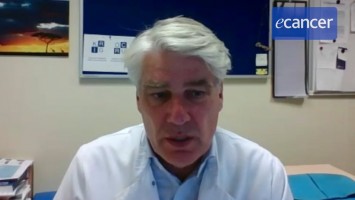ASCO 2011 Annual Meeting, 3—7 June 2011, Chicago
Development of lenvatinib for thyroid cancer
Professor Steven Sherman – MD Anderson Cancer Center, Texas, USA
I’d just like to hear about, there’s two things really, the drug that you’ve been looking at, lenvatinib, but also the clinical model, and this is radioiodine resistant thyroid cancer, and this is really, really interesting. So you came into this in the last four or five years, six years, something like that? Tell us how you got interested in lenvatinib and in the clinical model, because you’ve got some interesting data to talk about.
Sure. Well we came to the realisation that most people with differentiated thyroid cancer do well no matter what we do to them but there’s this clear grouping, 15-20% or so of people with differentiated thyroid cancer, who end up with disease that’s refractory to our standard treatment which is radioactive iodide. And the only treatment that’s been available in the US that was approved was doxorubicin, based on abysmal data that now would get laughed out of the FDA if it were presented.
That goes back to Pharmitalia, forty years ago in Milan.
Yes, exactly. The earliest publications came out of MD Anderson about thyroid cancer being treated with doxorubicin and very nice anecdotal information but these days most patients end up without cytotoxic chemotherapy. Nonetheless, we had this group of patients, and actually statistically a growing group of patients with advanced disease, and dying from thyroid cancer. A few molecular observations that really helped to frame where we went and one was the importance of angiogenesis; clinically we knew this as extremely vascular tumours.
Ask the surgeon.
Yes, ask the surgeon. And so this led us to at least hypothesise, as antiangiogenic therapies were being developed, that thyroid cancer might be a reasonable target. The other, going back into the ‘90s, was the emerging science about the oncogenes that were triggering thyroid cancer and most recently that BRAF was an important cause of about 40-50% of papillary thyroid cancers, and preferentially those that were radioiodine refractory and progressive. So this model began a number of years ago with identifying drugs that were going into phase I clinical trials that targeted VEGF receptors and also might target signalling along the MAP kinase pathway. And one of the first ones that we began working with, actually, was motesanib from Amgen and the phase II study for that was published in The New England Journal. It wasn’t all that successful but it set a model that in fact thyroid cancer studies could be done, could be successfully completed, and could yield scientifically good results. We’ve built on that and in the last five years, now culminating with lenvatinib, we’ve moved from a 14% partial response rate to a nearly 60% partial response rate.
That’s impressive.
Yes.
What does lenvatinib target, do you know?
Yes, like many of the other tyrosine kinase inhibitors, in vivo, in vitro, it targets VEGF receptors 1, 2 and 3; it targets PDGF receptor and KIT, but also targets fibroblast growth factor receptors, at least 1 through 4, and that may be one of the twists that might contribute to its possibly greater effectiveness in thyroid cancer. But again our interest also was that it targets a kinase called RET, which is important in medullary thyroid cancer, is a common oncogene in papillary cancer, although probably not seen that frequently in patients with advanced disease. But for all of those receptors, and kinases, being of interest in thyroid cancer, we thought it was worth pursuing at the phase I level.
Did you get any images of the thyroid while you were doing this treatment?
All of these are patients who’ve had primary treatment with thyroidectomy.
So there’s not a lot to image?
Right. So we have the standard tomographic imaging of metastatic disease and can measure response that way.
But I was thinking about MR.
By CT we can see significant shrinkage. Functional imaging is something that we would like to be pursuing more. It’s a more expensive direction to head but we would think that the FDG-PET imaging, which clearly correlates with progression in papillary thyroid cancer, would be a useful translational endpoint.
Sure. Congratulations, thanks very much for telling us about it, I appreciate it.
My pleasure.








